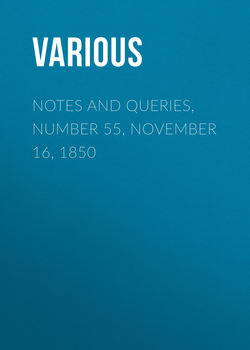Читать книгу Notes and Queries, Number 55, November 16, 1850 - Various - Страница 3
NOTES
NOTES ON THE SECOND EDITION OF MR. CUNNINGHAM'S HANDBOOK OF LONDON
Оглавление21. New Tunbridge Wells, at Islington.—This fashionable morning lounge of the nobility and gentry during the early part of the eighteenth century, is omitted by Mr. Cunningham. There is a capital view of it in Bickham's Musical Entertainer, 1737:
"These once beautiful tea-gardens (we remember them as such) were formerly in high repute. In 1733 their Royal Highnesses the Princesses Amelia and Caroline frequented them in the summer time for the purpose of drinking the waters. They have furnished a subject for pamphlets, poems, plays, songs, and medical treatises, by Ned Ward, George Colman the older, Bickham, Dr. Hugh Smith, &c. Nothing now remains of them but the original chalybeate spring, which is still preserved in an obscure nook, amidst a poverty-stricken and squalid rookery of misery and vice."—George Daniel's Merrie England in the Olden Time, vol. i. p. 31.
22. London Spa (from which Spa Fields derives its name) dates as far back as 1206. In the eighteenth century, it was a celebrated place of amusement. There is a curious view of "London Spaw" in a rare pamphlet entitled May-Day, or, The Original of Garlands. Printed for J. Roberts, 1720, 8vo.
23. Spring Gardens.—Cox's Museum is described in the printed catalogue of 1774, as being in "Spring Gardens." In the same year a small volume was published containing A Collection of various Extracts in Prose and Verse relative to Cox's Museum.
24. The Pantheon in Spa Fields.—This place of amusement was opened in 1770 for the sale of tea, coffee, wine, punch, &c. It had an organ, and a spacious promenade and galleries. In 1780 it was converted into a lay-chapel by the Countess of Huntingdon, and is now known as Northampton or Spa Fields Chapel. Mr. Cunningham speaks of the burying-ground (originally the garden), but singularly enough omits to notice the chapel.
25. Baldwin's Gardens, running between Leather Lane and Gray's Inn Lane, were, according to a stone which till lately was to have been seen against a corner house, bearing the arms of Queen Elizabeth, named after Richard Baldwin, one of the royal gardeners, who began building here in 1589.
26. Rathbone Place.—In an old print (now before me) dated 1722, this street is called "Rawbone Place." The Percy coffee-house is still in existence.
27. Surrey Institution, Blackfriars Road.—This building was originally erected, and for some years appropriated to the Leverian Museum. This magnificent museum of natural history was founded by Sir Ashton Lever, who died in 1788. It was afterwards disposed of by way of lottery, and won by Mr. James Parkinson, who transferred it from Leicester Place to the Surrey side of Blackfriars bridge.
28. Schomberg House, Pall Mall, (now, I believe, about to be pulled down), was once the residence of that celebrated "quack" Dr. Graham. Here, in 1783, he erected his Temple of Health. He afterwards removed to Panton Street, Haymarket, where he first exhibited his Earth Bath. I do not find any mention of Graham in Mr. Cunningham's book.
EDWARD F. RIMBAULT.
